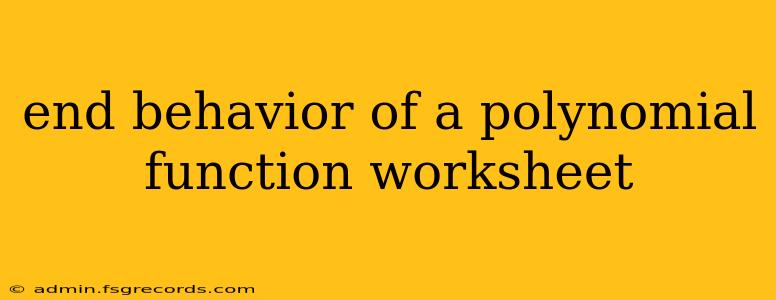Understanding the end behavior of polynomial functions is crucial for anyone studying algebra or precalculus. This worksheet will guide you through the process, providing examples and explanations to solidify your understanding. We'll explore how the degree and leading coefficient of a polynomial dictate its end behavior as x approaches positive and negative infinity.
What is End Behavior?
The end behavior of a polynomial function describes what happens to the y-values (function values) as the x-values become extremely large (positive or negative). It essentially tells us the direction the graph is heading at the far left and far right of the coordinate plane.
Key Factors Determining End Behavior
Two key features of a polynomial function dictate its end behavior:
- Degree: The highest power of x in the polynomial.
- Leading Coefficient: The coefficient of the term with the highest power of x.
Rules for Determining End Behavior
Here's a simple guide to determine the end behavior based on the degree and leading coefficient:
Even Degree:
- Positive Leading Coefficient: The graph rises on both the left and right sides. As x approaches positive infinity, y approaches positive infinity; as x approaches negative infinity, y approaches positive infinity. Think of a parabola opening upwards.
- Negative Leading Coefficient: The graph falls on both the left and right sides. As x approaches positive infinity, y approaches negative infinity; as x approaches negative infinity, y approaches negative infinity. Think of a parabola opening downwards.
Odd Degree:
- Positive Leading Coefficient: The graph falls on the left and rises on the right. As x approaches positive infinity, y approaches positive infinity; as x approaches negative infinity, y approaches negative infinity.
- Negative Leading Coefficient: The graph rises on the left and falls on the right. As x approaches positive infinity, y approaches negative infinity; as x approaches negative infinity, y approaches positive infinity.
Worksheet Exercises
Let's put this knowledge into practice with some examples:
Instructions: Determine the end behavior of the following polynomial functions. Describe the end behavior using the notation: as x → ∞, y → __; as x → -∞, y → __.
- f(x) = 2x³ + 5x² - 3x + 1
- g(x) = -x⁴ + 2x² - 7
- h(x) = -3x⁵ + x⁴ - 2x + 10
- p(x) = 4x⁶ - x³ + 6x - 2
- q(x) = x³ - 8x² + 16x
Solutions (Hidden for Self-Checking):
Click to reveal solutions
-
f(x) = 2x³ + 5x² - 3x + 1: Odd degree, positive leading coefficient. As x → ∞, y → ∞; as x → -∞, y → -∞
-
g(x) = -x⁴ + 2x² - 7: Even degree, negative leading coefficient. As x → ∞, y → -∞; as x → -∞, y → -∞
-
h(x) = -3x⁵ + x⁴ - 2x + 10: Odd degree, negative leading coefficient. As x → ∞, y → -∞; as x → -∞, y → ∞
-
p(x) = 4x⁶ - x³ + 6x - 2: Even degree, positive leading coefficient. As x → ∞, y → ∞; as x → -∞, y → ∞
-
q(x) = x³ - 8x² + 16x: Odd degree, positive leading coefficient. As x → ∞, y → ∞; as x → -∞, y → -∞
Advanced Exercises (Challenge):
- Sketch a possible graph for a polynomial function with an even degree and a negative leading coefficient.
- Describe the end behavior of a polynomial function with a degree of 7 and a positive leading coefficient.
- Can you have a polynomial function where the end behavior is: As x → ∞, y → ∞; and as x → -∞, y → -∞ ? Explain your answer.
This worksheet provides a solid foundation for understanding end behavior. Remember, practice is key to mastering this concept! By understanding end behavior, you'll be better equipped to analyze and graph polynomial functions.

